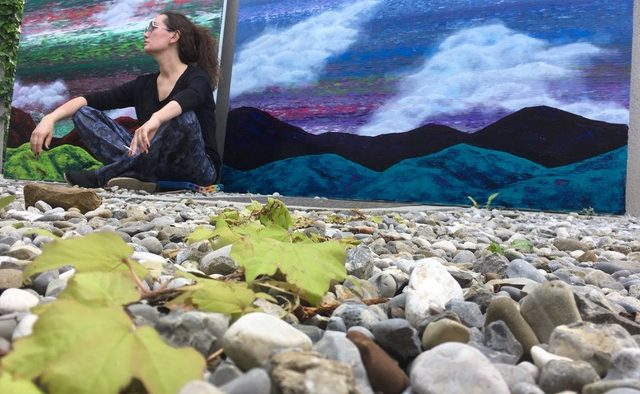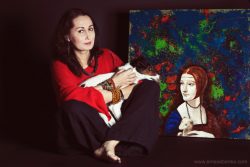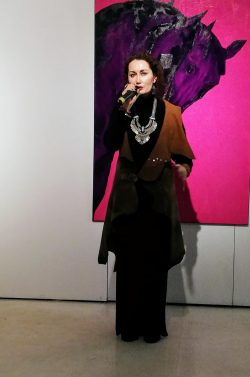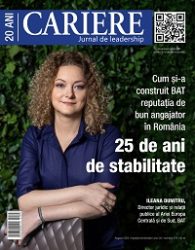Leyla Mahat – „Here I Am”: A Steppe Flower

As she describes herself in a poem, Leyla Mahat is a steppe flower that grows, fine and delicate, on lands where only the powerful and the unafraid can live.
Leyla Mahat is one of the most renowned artists in Kazakhstan and enjoys a well-deserved international recognition. She grew up in the land between the steppe and the mountains. Now she paints these lands. She is a calm, open and free spirit.
While waiting to speak to Leyla, I had plenty of time to enjoy her paintings. This is what it felt like:
Love. Horses. Mountains. Clouds. Colours.
Not sadness, possibly melancholy.
Contemplation, definitely.
A wandering spirit, longing but not lost.
A restless spirit, looking for Home.
Hope. Trust. Faith.
Alternating ardour and purity.
A spirit that flies over life. Gentle and quiet. Like a glider.

Photo: Leyla Mahat
What thrills you, these days?
Everything that is my duty makes me enthusiastic. I must finish what I have to do. Women have duties – as a mother, wife, teacher. It must make you enthusiastic, you know? It is your lifestyle and you are choosing it yourself. For me, it’s like this: if you are not going to do your duty, just don’t do it. It’s quite simple.
What makes me happy? To meet good people, smiling, whose eyes are not lying, to see my kids smiling, to do small things for my husband – that really makes me happy, even if he sometimes doesn’t understand what I did, it’s ok. To see what my students are doing and what victories they have of themselves, it’s making me happy.
How are you guiding your students?
It’s a difficult question, on the one hand. But on the other, it’s quite simple: if they need me, I always support my students, I’m always right behind them. Thanks to technology, there are a lot of ways that they can show me paintings and ask questions. It takes me a few minutes to answer, to look at their work, to correct something or simply say something they need to hear. I feel responsible for them. Some of my students, even after they have finished university and are now studying in Milan or Moscow, they still write to me and I continue to support them, because for me it is very important to not leave them if they need me.
You seem to have a very good connection to them.
If one wants to create something and they don’t trust themselves, they will not connect to anybody, they just concentrate on themselves and on what they think it’s important.
When that happens, do you notice it?
Sometimes. Many people do this. I don’t think it’s very normal for artists to think like this, but for me – if somebody who is creating new things for people at some point becomes snobbish, then they are no longer creating for people.
Are you on the lookout for talent? At times people don’t know who they are – do you approach people to awaken them to themselves?
I am not looking for someone to help, but I am always open. I am on the social media and if people write to me, asking for help or my opinion, I am always open and I always answer.
How did you know you were an artist?
I didn’t. It was not my choice, actually I never thought to choose this as a profession, as my career. When I was a child, my father took me to art school.
Do you remember what that felt like – your first contact with art?
I remember a lot from the art school – and maybe the most important thing, that made me sure that I have to continue on this path, is that when I work I lose track of time. I forget about time completely. Of course, there was a lot of fighting with teachers who did not understand me and I didn’t understand them. It’s ok, this is normal in the education process, this always happens. Sometimes you have to find your teacher, or the teacher has to find their students to make a good contact, one that serves development.
My problem with time has not changed, I still forget about time when I work, I must set alarms in order to do the other things that I need to do that day – like pick up my kids from school etc.
What does it feel like to paint, apart from forgetting the time? What happens to you when you paint?
I am just happy. And it’s a very strange process, because, sometimes it’s like a game with time – sometimes I am sure that this particular part of my work will take a lot of time, I’m sure that I will spend hours doing this or that, only to look at the watch and realize that it only took a few minutes or maybe one hour to do it. At times, this seems impossible to have happened like this. I don’t know how it happens – maybe something from high above makes these things possible and helps me do it, I don’t know.

Photo: Leyla Mahat
Can you talk to us about some of the challenges you had to face, as an artist, and how you overcame them?
Challenges? What challenges? Artists don’t have challenges (laughs). You are in Europe, and there is a so-called art market, here. The art market is a good thing, on the one hand, but on the other hand, the art market is run by managers, dealers, gallerists. This all depends on personality, though. And you never know who will listen, accept, see – a lot depends on chance.
So how do you stay strong, how do you stay true to yourself, when so many people are trying to turn you into what’s good for the market?
Being yourself is not difficult, if being yourself is what you really want. If you want to be someone other than yourself…I don’t know what that’s like, because I never tried it. But if someone comes to me and tells me what I have to paint and how I should paint it, I tell them: Look, if I do this, it would not be me. And I know that if I create something that is not me, it will be pushed out, it won’t come naturally, and it would be dangerous – not only for me, but for everyone around me.
What do you think art brings into our lives and how do we build more beauty into our lives? What is the aim of art? How do we help pragmatics find use in art and make time for it?
Art is so strange, you know, especially fine art. You know, when the TV came we thought theatre will die, when photography appeared they thought painting will disappear. But people still keep art, and they still do it, and produce it – even in this digital world, which is almost not understandable – so this means that we need it, we really need it. It’s obviously not enough to put a digital display on the wall and change the images – that doesn’t make one happy, because it is not a choice, it’s just marketing and market. When you want to see a particular painting, or sculpture, or listen to a particular piece of music – that is really your choice, it is something you truly choose yourself. Because if a creator – whether an actor, composer, fine artist – still does it, even in the business world of today, when artists are not even well paid, it means that people need art. If there is art, it means that the world needs it.
Our world is very fast, these days, uncomfortably fast. Do you think we also love art because it makes us stop a little bit and go within, and go deeper rather than faster, faster, faster?
The time of your life is a personal choice. People stop listening to the news and go back to reading books. Because it makes people human. It reminds us of something very special, which is very tiny, but it’s really very important for being human.
Talk to us about your choice of colors.
My husband tells me my voice is low, but I am screaming with my colors. I am from Kazakhstan. And Kazakhstan is at the crossroads of the Silk Road. And there is a lot of influence from different cultures there. I studied in Kazakhstan, in Sankt Petersburg, Berlin. When you study in Russia, your colors must be nuanced. When you study in Kazakhstan there’s a lot more freedom in terms of colors, when you study in Berlin you are free to do what you want, just express yourself. But the history of the fine art of Kazakhstan is not the classical fine art of Kazakhstan, it’s not a very old one. We grew up with the handicrafts of our grandmothers and great-grandmothers and we saw very wild and very colorful things around us and they have stayed with us. You will remember these colors.
Why did they choose such intense colors?
My explanation is because the steppe is huge, never-ending, and you have to mark your house, it must be seen and identified in the steppe. You need colors that will make your house recognizable, identifiable. Especially if someone is travelling and is needs help. In a nomadic life everything is mobile, everything has meaning and everything is usable. Even colors.
How else does Kazakhstan show up in your work, the spirit of it?
Kazakhstan is huge, as a territory. Kazakhstan, for me, is the tales of my grandfather, is the songs of my great grandmother, it’s the emotions that make me feel home, which is very important for me. Family traditions – which are based on the traditions of tribes, clans…it’s all very important for us.
Kazakhstan is not just geography for me. It’s the traditions and it’s the relationships in the family. Far relatives are very close, in our culture, we are very tight. It’s about identity. Nomadic people need their identity. You have to follow your tribe. Every Kazakhstan has to know at least 7 generations.
What inspires you?
Everything.
Here I Am – what is about yourself you would love people to see, in this exhibition
You said it yourself – we’re going very fast, these days. Maybe I want to stop some people a bit, not everyone, but some people, who come to the gallery. Maybe not stop everyone walking down the street, but maybe just somebody – just catch some attention, catch someone’s eye, help them stop running, give their mind a break from the difficult things.

Leyla Mahat, at the „Here I Am” exhibition – Galateca, Bucharest, March 11th.
Photo: Felicia Luca
What about horses?
The horse is a holy animal, in Kazakhstan. We ride them, we grow up with them, we eat them. It’s a best friend, it’s part of our life, it’s a part of Kazakhstan’s soul. Without horses it’s impossible to even imagine to be in Kazakhstan. Our children – we don’ even have to teach them, you just push them towards the horse and they start riding, somehow. I don’t know how they do it. And they are 4, 5 years old.
How do you know when you are on the right path – when it comes to your work, a project, life choices?
If it makes me happy, I choose it.
As an art gallery manager – does that help you, as an artist, does it inform your art, how did you come to run a gallery, do you like that?
Actually, there weren’t enough possibilities to show the art of my colleagues, friends, my art, when I came to Astana, in 2007. So I decided to create a place.
You’ve traveled a lot, and you have also studied in many places of the world. How has this enriched you?
In the Orient, especially in Kazakhstan, we have a different kind of horoscope. In Europe, people call it the Chinese horoscope, but for us it’s just the normal, nomadic horoscope. I was born in the year of the dog. And the dog is always educating you. So, for me, it is always very important to know something new. It would be very easy to be happy with what I have accomplished (I have a doctorate, and this and that), but this isn’t my way. If there is even the smallest possibility to learn something new, I will make the most of it. Otherwise, I would regret it terribly. It’s important to always add something new in your life – it’s the nomadic way of being, actually: we are always adding something new in our life, while also keeping our identity.
How do new ideas come to you?
It has to do with inspiration. And you do not wait for inspiration. You must work. And if you start working, the channel will open. Somehow, it opens. So, new ideas just come, because you are doing something and you are opening the channels of your soul. And ideas come.
Leyla Mahat has expressed her joy to be able to see how beautiful Romania is and her hopes that Romania and Kazakhstan will strenghten their intercultural relations, because, as Leyla says:
„I do believe good people are the same in every country, even if they speak different languages, even if they have different traditions. Good people are good people, no matter the country or the continent they live in.”
Leyla Mahat is an artist from Kazakhstan. She is an Associate Professor in the Faculty of Fine Arts at the National University of Arts in Kazakhstan, has held exhibitions in Italy, USA, India, China, Germany, Japan, Belgium, UK. Leyla has won several awards, such as the State Medal Award – 20 Independence, for her contribution to the Kazakh culture, and the Franz Kafka Medal, received in Prague, Czech Republic.
Leyla Mahat’s exhibition, HERE I AM, was brought to the attention of Romanian art lovers by KMG International, in partnership with the Embassy of the Republic of Kazakhstan in Romania.
„The exhibition proposes a discourse on finding one’s own identity and on the relationship between humanity and nature, universal issues that are addressed daily, as they are of major importance in today’s world,” said His Excellency, Mr. Daulet Batrashev, Ambassador of the Republic of Kazakhstan in Romania.
The exhibition was held at Galateca, in March, 2019.
Photos: Leyla Mahat

